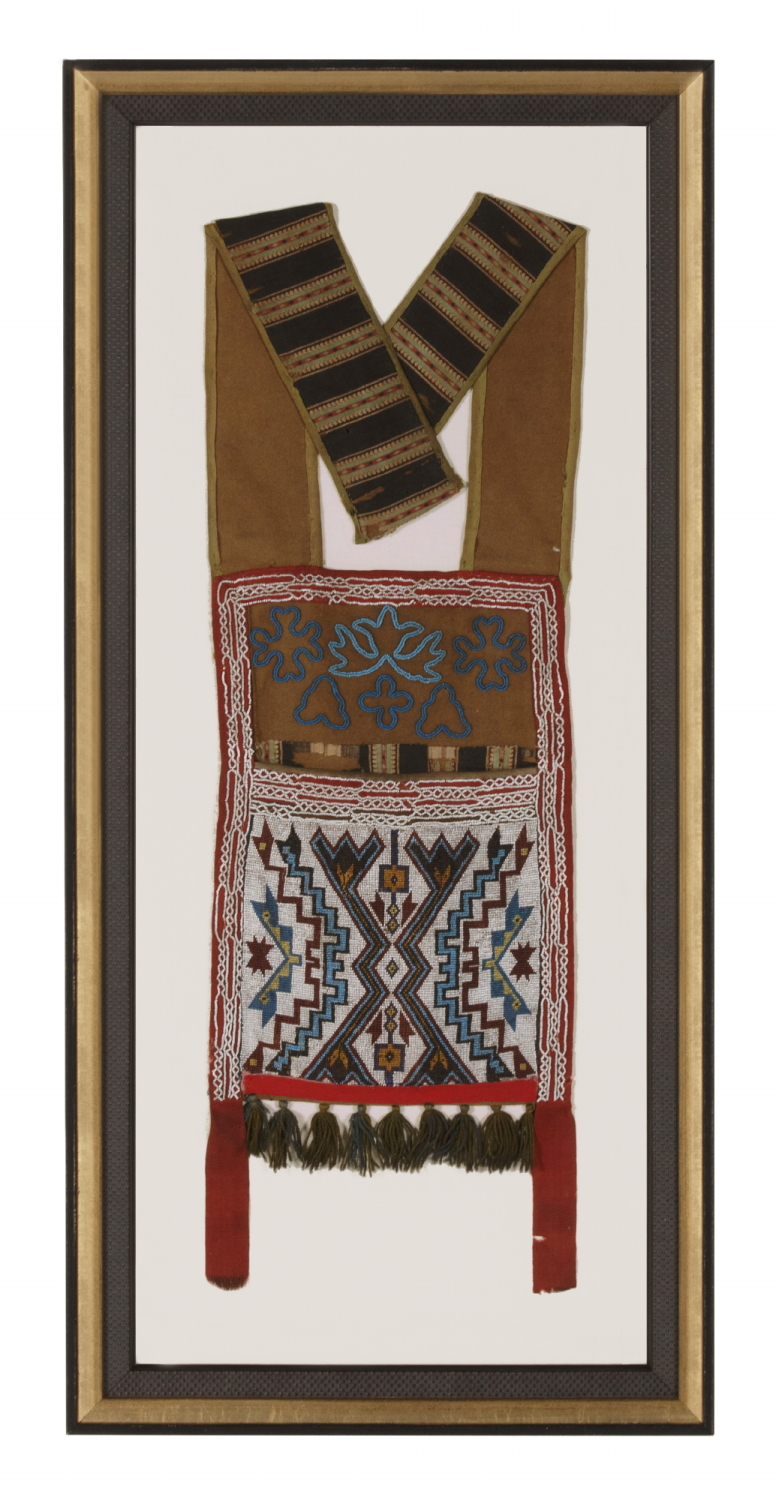
| |
BEADED, NATIVE AMERICAN BANDOLIER BAG, WITH GEOMETRIC AND FLORAL DESIGNS, CHIPPEWA OR WINNEBAGO INDIAN NATION, circa 1880 |
| |
|
| Dimensions (inches): |
Bag - 31" x 10", Frame - 38.75" x 18" |
| Description: |
|
Beaded, native American, bandolier bag, made ca 1880. The layout and designs utilized I would attribute as being of Chippewa / Ojibwe origin, or Winnebago / Ho-Chunk. The regions in which these native American peoples lived overlapped some, with the Chippewa ranging from what became North Dakota, Minnesota, Wisconsin, and Michigan, extending into Canada, and the Winnebago residing in parts of Wisconsin and Minnesota, but extending into what would become Iowa and Nebraska. Both utilized similar step-down geometric designs, terminating in stylized arrow fletching, plus elongated, eight-pointed, Lemoyne stars, and a similar layout of panels, sometimes with open floral work in the upper register, similar to what is present here, and geometric borders that utilized a single color of beads.
I presume that the work of one tribe probably influenced the other. Because the Winnebago were nearly wiped out by small pox in the mid-18th century, and then again in the 1830's, I think that the origin is more likely Chippewa. Regrowth of the Winnebago people over time came from intermarriage with neighboring tribes, which would certainly account for similarities in beadwork on bandolier bags. There is also some overlap in the designs used by the Potawatomi, who actually gave the Ho-Chunks the name "Winnebago," and whose range overlapped in present-day Wisconsin, also encompassing regions of what would become Oklahoma, Kansas, Illinois, Indiana, Michigan, and parts of Canada. There would have certainly been intermarriage between the Chippewa and Potawatomi, whose range had even greater overlap.
Bandolier bags are large, heavily beaded pouches with a slit at the top. They have a beaded strap worn diagonally over the shoulder, thus resting the bag at hip level. The design is created using glass beads, a European trade good that replaced the traditional porcupine quills. The bags themselves are typically constructed from trade cloth, such as cotton, wool, velvet, or leather.* This particular example is made primarily of tan wool broadcloth, a terrific printed cotton fabric of the 1860-70 era, black with geometric design stripes, and decorated with dynamic red, blue, black and gold geometric beadwork on a white beadwork ground. Woodlands floral designs adorn the upper register, above the mouth of the bag, in two shades of blue. The bag is trimmed with green wool or cotton tape and broad red wool herringbone tape, a a fringe made of knotted blue and green wool yarn. This is a very desirable example because of its beauty and its early fabrics, most of which pre-date the bag by 10-20 years and were undoubtedly acquired by trade with various parties.
The Great Lakes Native American beaded bandolier bag was copied from those used by European soldiers to carry cartridges for their rifles. Early bags did not have a pocket, but were solely for decoration. Beaded bandolier bags were produced mainly from the latter half of the 19th century through the first half of the 20th century, but they continue to be made today. Floral designs on bandolier bags are typical of Great Lakes Native American work. Such designs first appeared around 1800 and by 1900 had become the dominant pattern in the area. Bandolier bags are constructed and beaded by women, though they are used primarily to complete the ceremonial outfits worn by men. There are, however, examples of older women wearing them in photographs. Sometimes more than one bag is worn. These bags are considered objects of prestige within the tribes that produced them.*
Mounting: The bag has been hand-stitched to a background of 100% hemp fabric. It was then placed in a 2-part frame consisting of a basket weave pattern, dark brown liner with a reddish cast, surrounded by a narrow black-painted and gilded molding. A shadow box was created to accommodate the thickness of the textile and enhance its presentation. The glazing is U.V. protective Plexiglas.
Condition: There is moderate to significant breakdown in the printed black cotton fabric. Where needed this was professionally stabilized with an archival textile adhesive. There is very minor mothing and there is some fading. There is a small nick in the red wool tape.
* Source: Milwaukee Public Museum |
|
|
| |
|
| Primary Color: |
brown, red, multicolored |
|
| Earliest Date: |
1875 |
|
| Latest Date: |
1885 |
|
| For Sale Status: |
Sold |
|
| Price |
SOLD |
|
| E-mail: |
info@jeffbridgman.com |
|
 |
|
Page Views:... 7760 |
|


